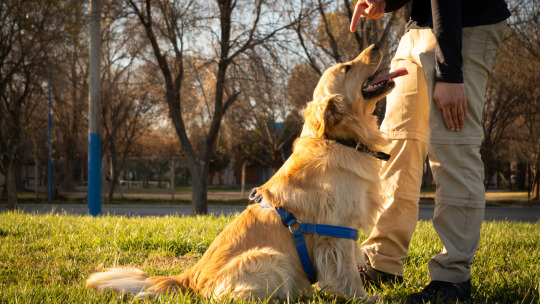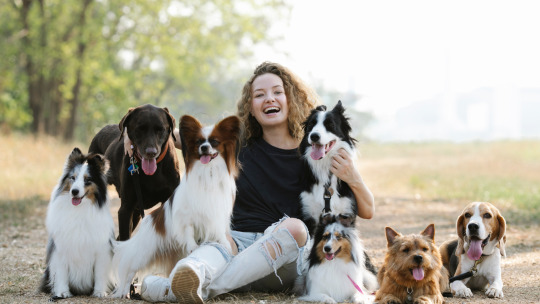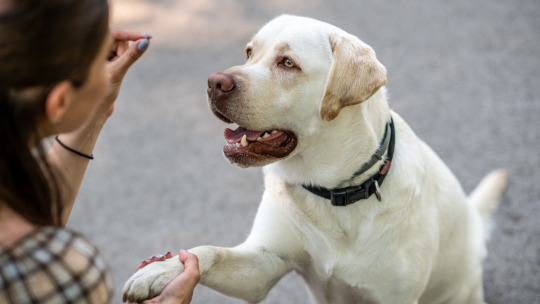Text
Awaken The “Optimist” in Your Dog
Introduction
Understanding Optimism in Dogs
Definition of optimism
Dog optimism is the natural inclination of these animals to view life positively and expect good things to happen, especially in the face of difficulties.


You can also try this product : Awaken the “Optimist” in Your Dog
How optimism manifests in dogs
Dogs who are optimistic frequently exhibit traits including wagging their tails, easy body posture, and an eagerness to interact with their environment. They are resilient and recover from failures fast.
Benefits of Optimism in Dogs
Improved overall well-being
Comparatively speaking, pessimistic dogs are more likely to be emotionally well and have lower stress levels. Their optimistic outlook adds to their feelings of happiness and fulfillment.
Enhanced resilience
Dogs that are optimistic are better able to cope with pressure and adjust to changes in their surroundings. They show a stronger desire to try new things and take on novel tasks.
Better coping mechanisms
Dogs who are optimistic tend to be better at handling hardship, showing signs of problem-solving and an increased capacity to get beyond barriers. They can stay upbeat even in difficult situations because of their positive mindset.
Factors Influencing a Dog's Optimism
Genetics
A dog's demeanor and perspective on life are influenced by hereditary predispositions. It's possible that some breeds are more naturally hopeful than others.
Early life experiences
Early life events that impact a dog's outlook on the world and degree of optimism include socialization, training, and contact with people and other animals.
Environmental factors
The way a dog is raised—its living circumstances, daily schedule, and exposure to stimuli—can affect how positive and optimistic they are overall.
Signs of Optimism in Dogs
Positive body language
Dogs that are optimistic frequently have open body language, showing off their loose muscles, waving tails, and alert demeanor. They could approach individuals and circumstances with eagerness and curiosity.
Eagerness to explore
Dogs that are optimistic show that they are eager to explore their environment and try new things. They could be curious and adventurous, actively looking for new stimuli.
Quick recovery from setbacks
Dogs who are optimistic tend to be resilient and swiftly recover from failures or unpleasant experiences. Despite difficulties, they exhibit a cheerful disposition and a determination to keep interacting with their surroundings.
Techniques to Foster Optimism in Dogs
Positive reinforcement training
Dogs' positive behaviors can be reinforced by using positive reinforcement strategies like praise and rewards. Through the process of linking pleasant experiences to desirable behaviors, pet owners can help their pets develop a more positive mindset.
Enrichment activities
Giving dogs engaging activities that stimulate their minds, such puzzle toys, interactive games, and outdoor excursions, can encourage curiosity and discovery in them and make them happier.
Consistent routines
Dogs might benefit from a sense of stability and predictability that comes from regular daily routines, such as feeding schedules, exercise routines, and social contacts. This can enhance their general well-being and optimism.
Avoiding Pessimistic Behaviors
Recognizing signs of pessimism
It's critical for dog owners to identify symptoms of pessimism in their animals, including avoidance behaviors, withdrawal, and extreme fear or anxiety.
Addressing underlying causes
Dogs who are experiencing negative emotions can benefit from identifying and addressing underlying causes of pessimism, such as past traumas, health problems, or environmental stressors. This will help the dogs adopt a more optimistic view.
Creating a supportive environment
It is possible to foster confidence and optimism in dogs by providing them with a loving, patient, and understanding environment.
Bonding with an Optimistic Dog
Building trust and rapport
Developing a solid relationship with dogs that is founded on mutual respect and trust is crucial for encouraging optimism. Dogs and their owners can develop a closer relationship through regular training sessions and positive interactions.
Engaging in mutual activities
Playtime, training sessions, and outdoor experiences are examples of things that both the dog and owner enjoy doing together and can strengthen the bond and encourage positive behavior.
Understanding your dog's needs
It is possible to customize interactions and activities to encourage optimism and general well-being by taking the time to get to know your dog's unique requirements, preferences, and personality features.
Case Studies: Real-Life Examples of Optimistic Dogs
Stories showcasing optimistic behavior
Dog owners who want to foster optimism in their own pets may find motivation and wisdom in hearing about the experiences of real-life optimistic canines.
Lessons learned from these cases
Thinking back on the takeaways from these case studies—like the value of resilience, positive reinforcement, and fostering a caring environment—can help dog owners in their endeavors to bring out the best in their pets.


You can also try this product : Awaken the “Optimist” in Your Dog
Conclusion
Recap of key points
Developing optimism in dogs can yield several advantages, such as increased resilience, better coping strategies, and general well-being. Owners can assist their pets in leading happier and more meaningful lives by learning what influences optimism in dogs and putting positive behavior-fostering practices into practice.
Encouragement to nurture optimism in dogs
It is our responsibility as responsible pet owners to provide our dogs affection, support, and encouragement so they can develop a positive attitude on life. By bringing out the optimist in our dogs, we improve our relationship with them and add to their general contentment and wellbeing.
DISCLAIMER
Links included in this description might be affiliate links. If you purchase a product or service using the links that I provide, I may receive a small commission.
#optimist in all of us#sleeping optimist in all of us#how to awaken your inner magic#how to awaken your inner power#can awaken a sleeping#to awaken each morning#how to awaken inner power#how to awaken inner magic#how to invest in a bear market#simerjeet singh speech in english#the optimist#dog sits in pants#pug in the toilet#jen brister the optimist#dogs care#bungou stray dogs#homeless dog#dog rescue#new dog#dog
0 notes
Text
A New Dog Moves In
Preparing for the Arrival
Setting up the environment
Before the arrival of a new dog, it's essential to prepare the environment to ensure a smooth transition. This involves creating a safe and comfortable space for the new addition, including a designated sleeping area, feeding station, and access to water. Additionally, removing any hazards or potential dangers from the living space is crucial to prevent accidents or injuries.
You can try this product: A new dog moves in


Gathering necessary supplies
Having the right supplies on hand is essential for welcoming a new dog into the home. This includes basics such as food and water bowls, a leash and collar, a comfortable bed or crate, and appropriate toys for mental stimulation. Depending on the dog's needs, additional items such as grooming supplies, training treats, and a doggy first-aid kit may also be necessary.
Welcoming the New Arrival
Introducing the new dog to the home
When the new dog arrives, it's essential to make introductions gradually and calmly. Allow the dog to explore their new surroundings at their own pace, offering gentle encouragement and reassurance. Providing a quiet space where the dog can retreat if feeling overwhelmed is important, as it allows them to adjust to their new environment in their own time.
Establishing routines and boundaries
Consistency is key when it comes to establishing routines and boundaries with a new dog. Setting clear expectations from the beginning helps to prevent confusion and promote positive behaviors. This includes establishing feeding schedules, potty training routines, and rules for behavior in the home. Consistent positive reinforcement and gentle correction are effective methods for teaching desired behaviors and boundaries.
Bonding with the New Dog
Spending quality time together
Building a strong bond with a new dog requires spending quality time together. This includes engaging in activities such as walking, playing, and training sessions that allow for positive interaction and communication. Incorporating activities that the dog enjoys and finds rewarding helps to strengthen the bond and build trust between the dog and their new family members.
Building trust and rapport
Building trust and rapport with a new dog takes time and patience. It involves being patient, consistent, and understanding of the dog's needs and preferences. Providing love, attention, and affection in a gentle and respectful manner helps to foster a sense of security and belonging for the dog, laying the foundation for a strong and lasting bond.
Addressing Challenges and Concerns
Dealing with anxiety or fear
It's not uncommon for new dogs to experience anxiety or fear when adjusting to their new environment. This may manifest as nervous behaviors, such as pacing, panting, or hiding. Providing a calm and supportive environment, along with gentle reassurance and positive reinforcement, can help to alleviate anxiety and build the dog's confidence over time.
Handling behavioral issues
Addressing behavioral issues with a new dog requires patience, consistency, and positive reinforcement. Identifying the root cause of the behavior and addressing it proactively is essential for promoting positive change. Working with a professional trainer or behaviorist can provide valuable guidance and support in addressing behavioral issues effectively and responsibly.
You can try this product: A new dog moves in


In conclusion, welcoming a new dog into the home is an exciting and rewarding experience. By taking the time to prepare the environment, establish routines and boundaries, bond with the new dog, and address any challenges or concerns that may arise, dog owners can ensure a smooth transition and lay the foundation for a happy and harmonious relationship with their new furry companion. With patience, love, and understanding, the bond between a dog and their new family members will continue to grow stronger with each passing day.
DISCLAIMER
There is an affliatelink of the best product in this article which may make some profit for me
#new dog#new games#roll over#live show#dog rescue#rescue dog#aggressive#rescue dogs#best day ever#homeless dog#live dog demo#dog bites kid#aggressive behavior in dogs#movie reviews#stop aggressive dog behavior#aggressive training for dogs#best dog tricks#movie synopses#dog bites child#dog toy reviews#getting a new dog#movie critiques#movie summaries#dog reviews food#adopting a new dog#cesar millan live#rescue dog training#dog
0 notes
Text
The Benefits of Healing Herbs for Dogs
Introduction
In recent years, there has been a growing interest in using natural remedies, such as healing herbs, to support the health and well-being of dogs. These herbs offer a holistic approach to veterinary care, providing a range of benefits without the potential side effects of conventional medications.
You can try also this product:Online course "Healing herbs for dogs"


Common Healing Herbs for Dogs
Turmeric
Turmeric contains curcumin, a compound known for its anti-inflammatory and antioxidant properties. It can help alleviate symptoms of arthritis and joint pain in dogs.
Ginger
Ginger is well-known for its ability to soothe upset stomachs and aid digestion. It can be beneficial for dogs experiencing nausea or gastrointestinal issues.
Chamomile
Chamomile has calming properties that can help reduce anxiety and promote relaxation in dogs. It is often used to alleviate stress-related behaviors and promote better sleep.
Lavender
Lavender has a calming and soothing scent that can help dogs relax and relieve anxiety. It is commonly used in aromatherapy and can be beneficial for dogs with separation anxiety or nervousness.
Echinacea
Echinacea is a powerful immune booster that can help strengthen the immune system and support overall health in dogs. It is often used to prevent and treat infections.
Benefits of Healing Herbs for Dogs
Using healing herbs for dogs offers a range of benefits, including:
Anti-inflammatory properties: Many herbs, such as turmeric and ginger, have natural anti-inflammatory properties that can help reduce inflammation and pain associated with conditions like arthritis.
Digestive support: Herbs like ginger and chamomile can aid digestion and soothe gastrointestinal upset, making them useful for dogs with sensitive stomachs or digestive issues.
Anxiety relief: Herbs like chamomile and lavender have calming properties that can help reduce anxiety and stress in dogs, promoting a sense of calmness and relaxation.
Immune system boost: Herbs like echinacea can strengthen the immune system and help dogs fight off infections and illness, keeping them healthy and resilient.
Skin and coat health: Certain herbs, such as lavender, can help soothe and heal skin irritations and promote a healthy, shiny coat in dogs.
Administration and Dosage Guidelines
When using healing herbs for dogs, it's important to consider the form of administration and recommended dosage:
Forms of administration: Healing herbs for dogs are available in various forms, including capsules, tinctures, teas, and topical preparations. The form chosen may depend on the dog's preference and the condition being treated.
Recommended dosage: Dosage guidelines for healing herbs can vary depending on the dog's size, age, and health condition. It's essential to follow recommended dosage instructions provided by a veterinarian or herbalist to ensure safe and effective use.
Potential side effects and precautions: While healing herbs are generally safe for dogs, some may experience side effects or adverse reactions. It's important to monitor dogs closely for any signs of discomfort or allergic reactions and discontinue use if necessary. Additionally, certain herbs may interact with medications or underlying health conditions, so it's essential to consult with a veterinarian before starting any herbal treatment regimen.
You can try also this product:Online course "Healing herbs for dogs"


Consultation with a Veterinarian
Before using healing herbs for dogs, it's crucial to consult with a veterinarian:
Importance of seeking professional advice: A veterinarian can provide valuable guidance and recommendations for using healing herbs safely and effectively. They can assess the dog's health condition, provide personalized treatment recommendations, and monitor progress over time.
Integration with conventional veterinary care: Herbal remedies can complement conventional veterinary care and may be integrated into a comprehensive treatment plan for dogs with chronic conditions or specific health concerns.
Tailoring treatment plans: A veterinarian can tailor treatment plans to meet the individual needs of each dog, taking into account factors such as age, breed, health status, and any underlying medical conditions. They can also provide guidance on selecting the most appropriate herbs and dosage regimen for optimal results.
In conclusion, healing herbs offer a natural and holistic approach to supporting the health and well-being of dogs. By incorporating herbs like turmeric, ginger, chamomile, lavender, and echinacea into their care routines, dog owners can provide their furry companions with a range of benefits, from pain relief and digestive support to anxiety relief and immune system boost. However, it's essential to consult with a veterinarian before starting any herbal treatment regimen to ensure safe and effective use. With proper guidance and supervision, healing herbs can be a valuable addition to a dog's healthcare toolkit, promoting overall wellness and vitality.
DISCLAIMER
There is an affliatelink of the best product in this article which may make some profit for me.
#herbal medicine online course#tips for drinking chinese herbs#chinese herbs for sleep#healing herbs#crystal healing for beginners#how to use crystals for healing#herbs#crystals for healing#herbal medicine#keto for beginners#dried organic herbs for cats#herbal medicine for depression#herbal medicine for anxiety#natural healing#raw food diet for dogs#the best soap for healing psoriasis#how to use crystals for beginners#herbal remedies
1 note
·
View note